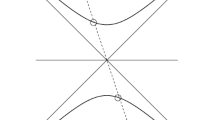Abstract
We consider the Tricomi problem with a type change line that does not coincide with any of the coordinate axes, with a circular sector in the ellipticity domain, and with a triangle formed by the type change line and segments of characteristics in the hyperbolicity domain. We also consider the adjoint problem. The solution of both problems is obtained in the form of a series. For a more general case with a curve of arbitrary shape in the ellipticity domain, we present the maximum principle for both problems.
Similar content being viewed by others
References
Moiseev, E.I., Differ. Uravn., 1990, vol. 26, no. 1, pp. 93–103.
Bitsadze, A.V., Nekotorye klassy uravnenii v chastnykh proizvodnykh (Some Classes of Partial Differential Equations), Moscow: Nauka, 1981.
Moiseev, E.I., Differ. Uravn., 1987, vol. 23, no. 1, pp. 177–179.
Author information
Authors and Affiliations
Additional information
Original Russian Text © N.O. Taranov, 2008, published in Differentsial’nye Uravneniya, 2008, Vol. 44, No. 10, pp. 1416–1419.
Rights and permissions
About this article
Cite this article
Taranov, N.O. Investigation of an analog of the Tricomi problem for the case in which the type change line does not coincide with coordinate axes. Diff Equat 44, 1478–1481 (2008). https://doi.org/10.1134/S0012266108100145
Received:
Published:
Issue Date:
DOI: https://doi.org/10.1134/S0012266108100145



